Marketing Fundamentals: Environmental Factors and Strategies Report
VerifiedAdded on 2021/04/17
|7
|1402
|30
Report
AI Summary
This report delves into the core concepts of marketing, emphasizing the processes essential for a new hotel business, including opportunity analysis, target market research, strategy design, program planning, implementation, and evaluation. It examines the impact of both micro and macro environmental factors, particularly economic forces such as taxation, inflation, and interest rates, on the hotel's operations and profitability. The report highlights the need for strategic responses to navigate these dynamic environments, especially in light of global economic challenges. Furthermore, it analyzes the marketing of Vegemite, discussing micro-environmental factors like competition and macro-environmental factors like demographic forces, showcasing how Kraft tailors its products to different market segments. The report provides recommendations for adapting marketing strategies to maintain competitiveness and address changing consumer needs.
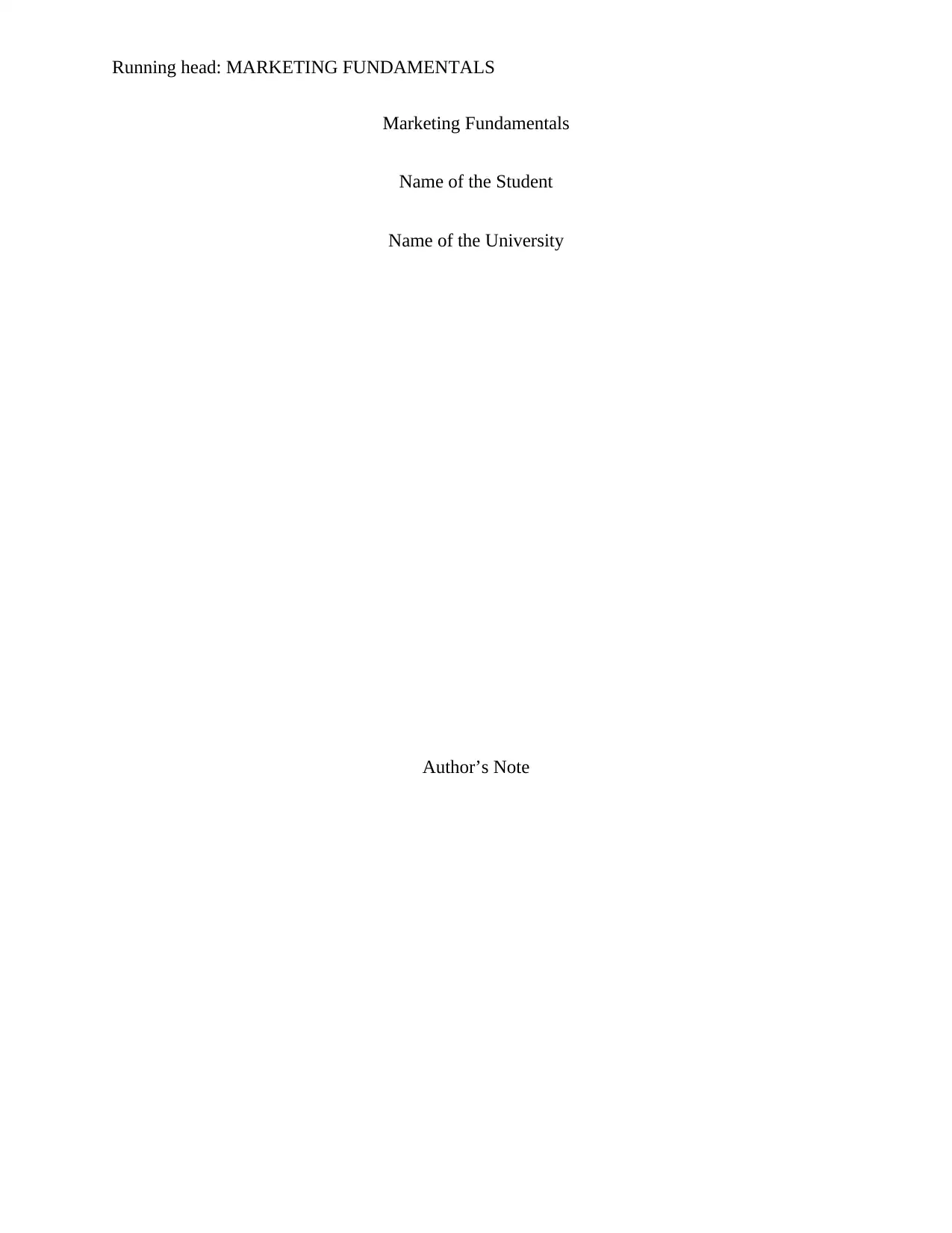
Running head: MARKETING FUNDAMENTALS
Marketing Fundamentals
Name of the Student
Name of the University
Author’s Note
Marketing Fundamentals
Name of the Student
Name of the University
Author’s Note
Paraphrase This Document
Need a fresh take? Get an instant paraphrase of this document with our AI Paraphraser
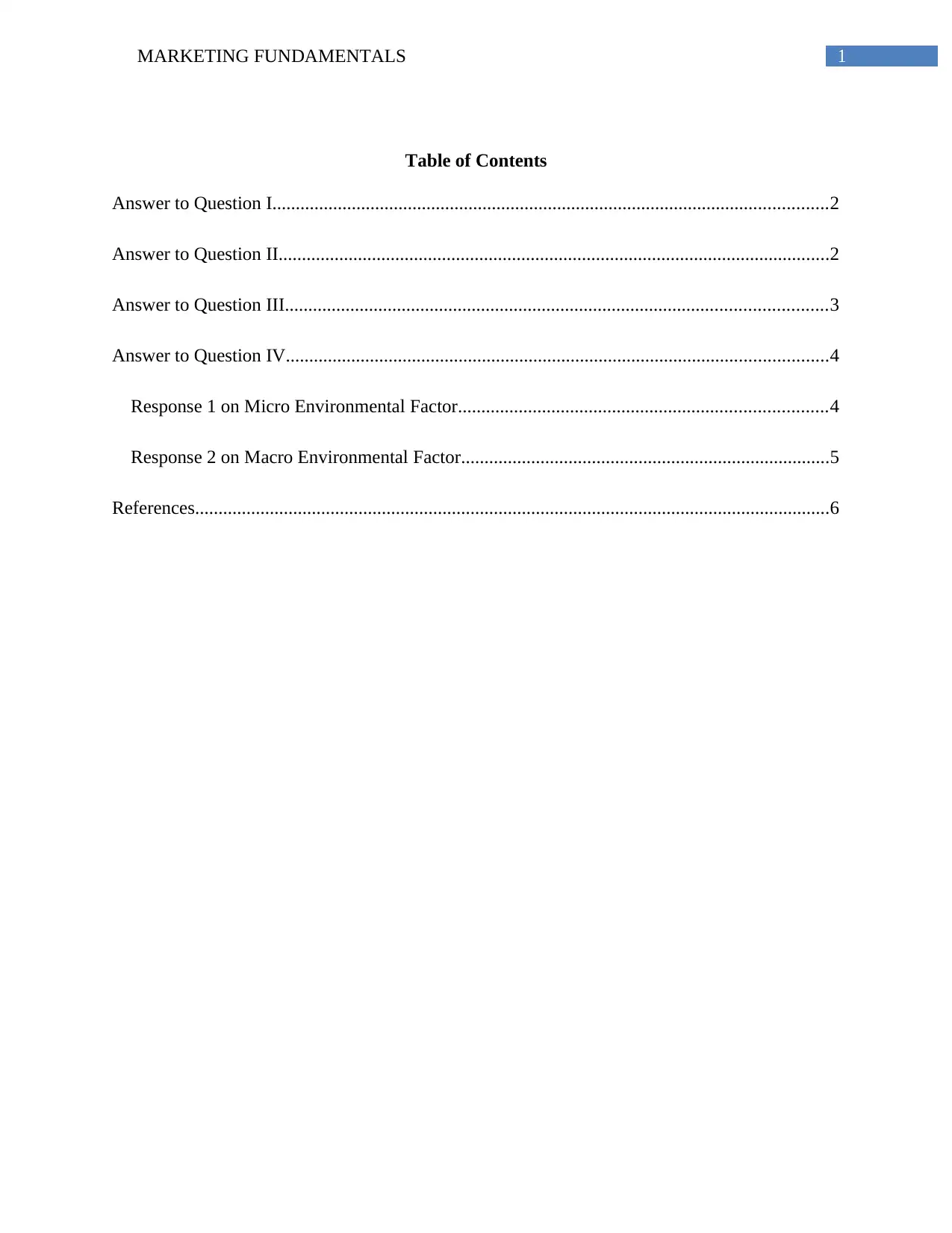
1MARKETING FUNDAMENTALS
Table of Contents
Answer to Question I.......................................................................................................................2
Answer to Question II......................................................................................................................2
Answer to Question III....................................................................................................................3
Answer to Question IV....................................................................................................................4
Response 1 on Micro Environmental Factor...............................................................................4
Response 2 on Macro Environmental Factor...............................................................................5
References........................................................................................................................................6
Table of Contents
Answer to Question I.......................................................................................................................2
Answer to Question II......................................................................................................................2
Answer to Question III....................................................................................................................3
Answer to Question IV....................................................................................................................4
Response 1 on Micro Environmental Factor...............................................................................4
Response 2 on Macro Environmental Factor...............................................................................5
References........................................................................................................................................6
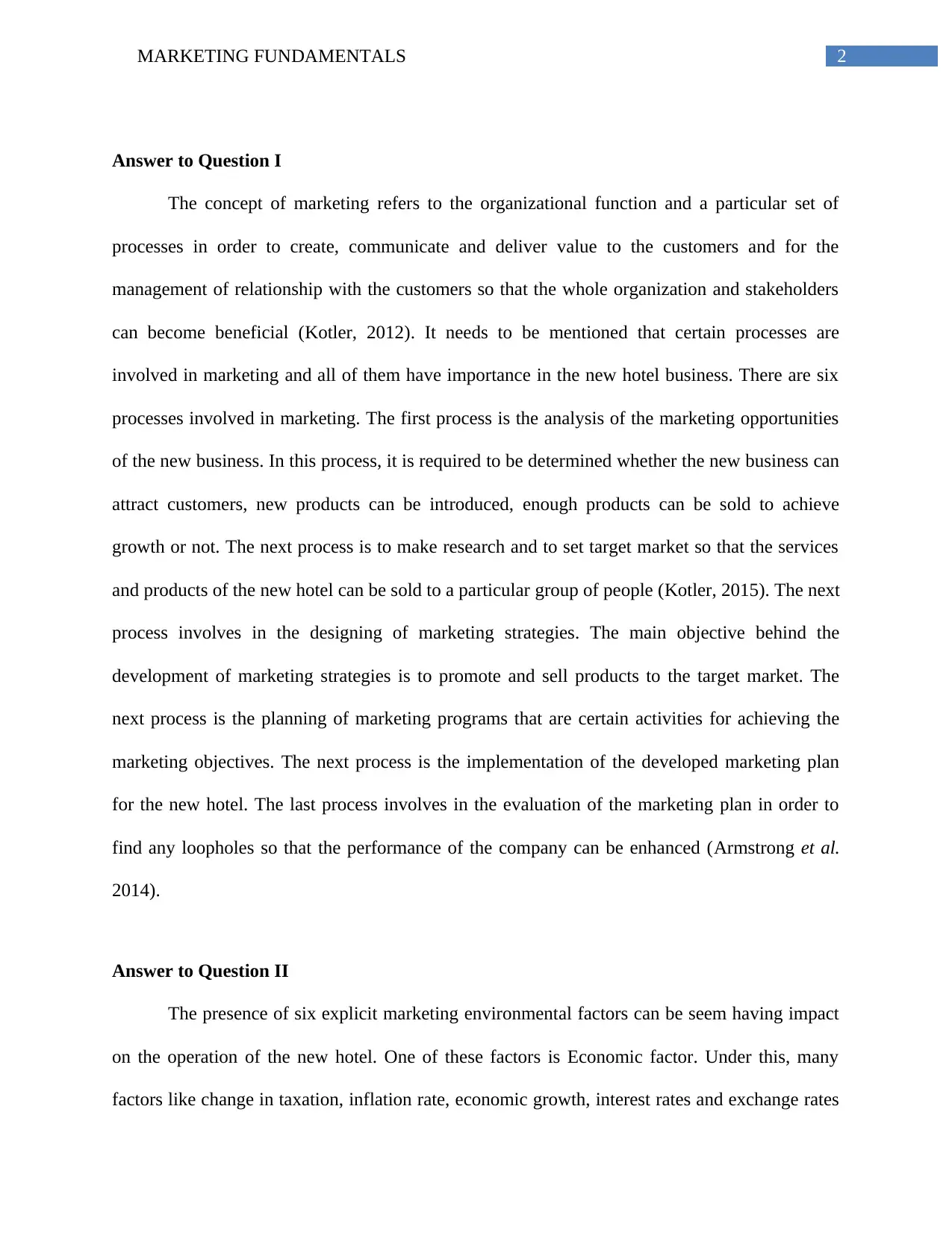
2MARKETING FUNDAMENTALS
Answer to Question I
The concept of marketing refers to the organizational function and a particular set of
processes in order to create, communicate and deliver value to the customers and for the
management of relationship with the customers so that the whole organization and stakeholders
can become beneficial (Kotler, 2012). It needs to be mentioned that certain processes are
involved in marketing and all of them have importance in the new hotel business. There are six
processes involved in marketing. The first process is the analysis of the marketing opportunities
of the new business. In this process, it is required to be determined whether the new business can
attract customers, new products can be introduced, enough products can be sold to achieve
growth or not. The next process is to make research and to set target market so that the services
and products of the new hotel can be sold to a particular group of people (Kotler, 2015). The next
process involves in the designing of marketing strategies. The main objective behind the
development of marketing strategies is to promote and sell products to the target market. The
next process is the planning of marketing programs that are certain activities for achieving the
marketing objectives. The next process is the implementation of the developed marketing plan
for the new hotel. The last process involves in the evaluation of the marketing plan in order to
find any loopholes so that the performance of the company can be enhanced (Armstrong et al.
2014).
Answer to Question II
The presence of six explicit marketing environmental factors can be seem having impact
on the operation of the new hotel. One of these factors is Economic factor. Under this, many
factors like change in taxation, inflation rate, economic growth, interest rates and exchange rates
Answer to Question I
The concept of marketing refers to the organizational function and a particular set of
processes in order to create, communicate and deliver value to the customers and for the
management of relationship with the customers so that the whole organization and stakeholders
can become beneficial (Kotler, 2012). It needs to be mentioned that certain processes are
involved in marketing and all of them have importance in the new hotel business. There are six
processes involved in marketing. The first process is the analysis of the marketing opportunities
of the new business. In this process, it is required to be determined whether the new business can
attract customers, new products can be introduced, enough products can be sold to achieve
growth or not. The next process is to make research and to set target market so that the services
and products of the new hotel can be sold to a particular group of people (Kotler, 2015). The next
process involves in the designing of marketing strategies. The main objective behind the
development of marketing strategies is to promote and sell products to the target market. The
next process is the planning of marketing programs that are certain activities for achieving the
marketing objectives. The next process is the implementation of the developed marketing plan
for the new hotel. The last process involves in the evaluation of the marketing plan in order to
find any loopholes so that the performance of the company can be enhanced (Armstrong et al.
2014).
Answer to Question II
The presence of six explicit marketing environmental factors can be seem having impact
on the operation of the new hotel. One of these factors is Economic factor. Under this, many
factors like change in taxation, inflation rate, economic growth, interest rates and exchange rates
⊘ This is a preview!⊘
Do you want full access?
Subscribe today to unlock all pages.

Trusted by 1+ million students worldwide
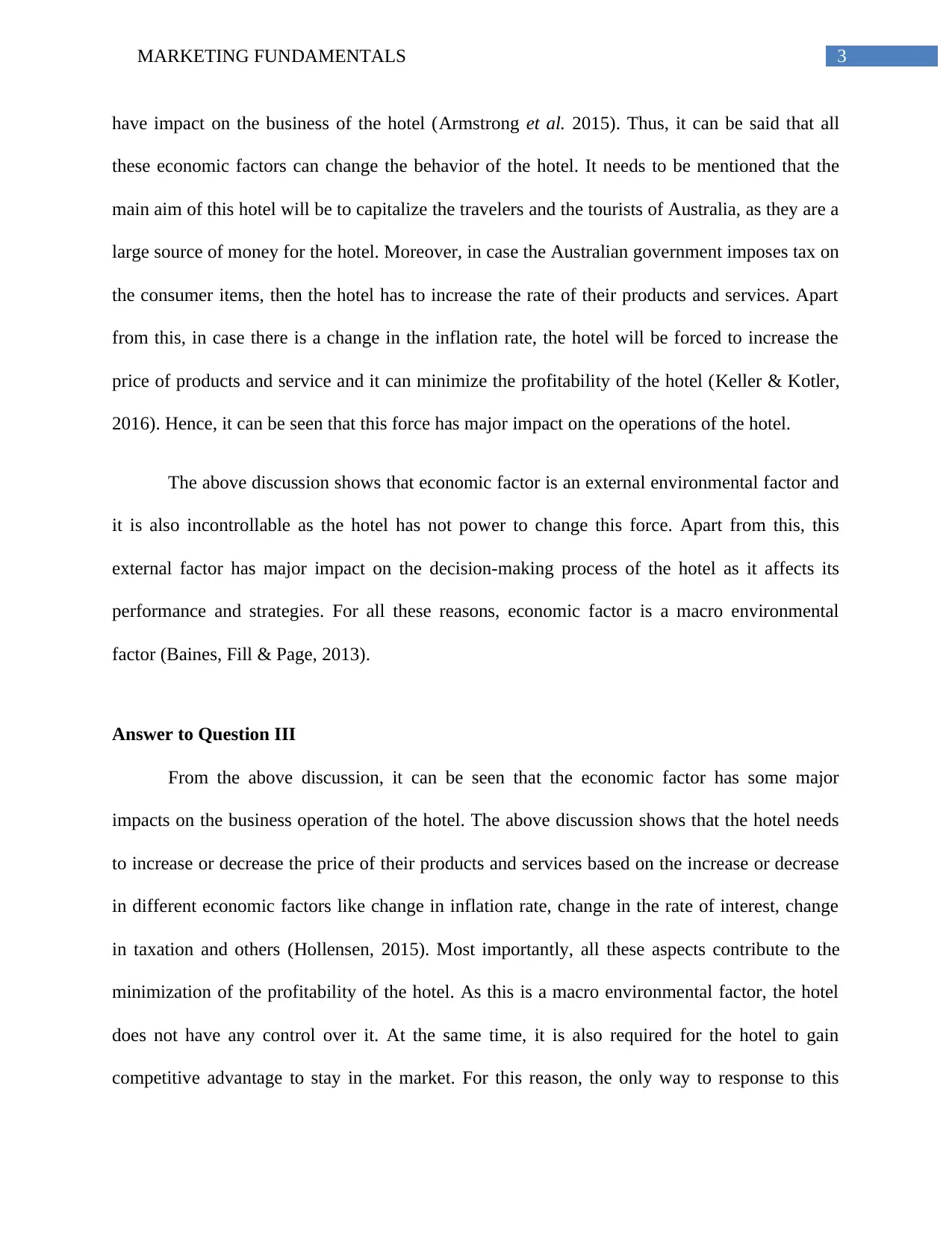
3MARKETING FUNDAMENTALS
have impact on the business of the hotel (Armstrong et al. 2015). Thus, it can be said that all
these economic factors can change the behavior of the hotel. It needs to be mentioned that the
main aim of this hotel will be to capitalize the travelers and the tourists of Australia, as they are a
large source of money for the hotel. Moreover, in case the Australian government imposes tax on
the consumer items, then the hotel has to increase the rate of their products and services. Apart
from this, in case there is a change in the inflation rate, the hotel will be forced to increase the
price of products and service and it can minimize the profitability of the hotel (Keller & Kotler,
2016). Hence, it can be seen that this force has major impact on the operations of the hotel.
The above discussion shows that economic factor is an external environmental factor and
it is also incontrollable as the hotel has not power to change this force. Apart from this, this
external factor has major impact on the decision-making process of the hotel as it affects its
performance and strategies. For all these reasons, economic factor is a macro environmental
factor (Baines, Fill & Page, 2013).
Answer to Question III
From the above discussion, it can be seen that the economic factor has some major
impacts on the business operation of the hotel. The above discussion shows that the hotel needs
to increase or decrease the price of their products and services based on the increase or decrease
in different economic factors like change in inflation rate, change in the rate of interest, change
in taxation and others (Hollensen, 2015). Most importantly, all these aspects contribute to the
minimization of the profitability of the hotel. As this is a macro environmental factor, the hotel
does not have any control over it. At the same time, it is also required for the hotel to gain
competitive advantage to stay in the market. For this reason, the only way to response to this
have impact on the business of the hotel (Armstrong et al. 2015). Thus, it can be said that all
these economic factors can change the behavior of the hotel. It needs to be mentioned that the
main aim of this hotel will be to capitalize the travelers and the tourists of Australia, as they are a
large source of money for the hotel. Moreover, in case the Australian government imposes tax on
the consumer items, then the hotel has to increase the rate of their products and services. Apart
from this, in case there is a change in the inflation rate, the hotel will be forced to increase the
price of products and service and it can minimize the profitability of the hotel (Keller & Kotler,
2016). Hence, it can be seen that this force has major impact on the operations of the hotel.
The above discussion shows that economic factor is an external environmental factor and
it is also incontrollable as the hotel has not power to change this force. Apart from this, this
external factor has major impact on the decision-making process of the hotel as it affects its
performance and strategies. For all these reasons, economic factor is a macro environmental
factor (Baines, Fill & Page, 2013).
Answer to Question III
From the above discussion, it can be seen that the economic factor has some major
impacts on the business operation of the hotel. The above discussion shows that the hotel needs
to increase or decrease the price of their products and services based on the increase or decrease
in different economic factors like change in inflation rate, change in the rate of interest, change
in taxation and others (Hollensen, 2015). Most importantly, all these aspects contribute to the
minimization of the profitability of the hotel. As this is a macro environmental factor, the hotel
does not have any control over it. At the same time, it is also required for the hotel to gain
competitive advantage to stay in the market. For this reason, the only way to response to this
Paraphrase This Document
Need a fresh take? Get an instant paraphrase of this document with our AI Paraphraser
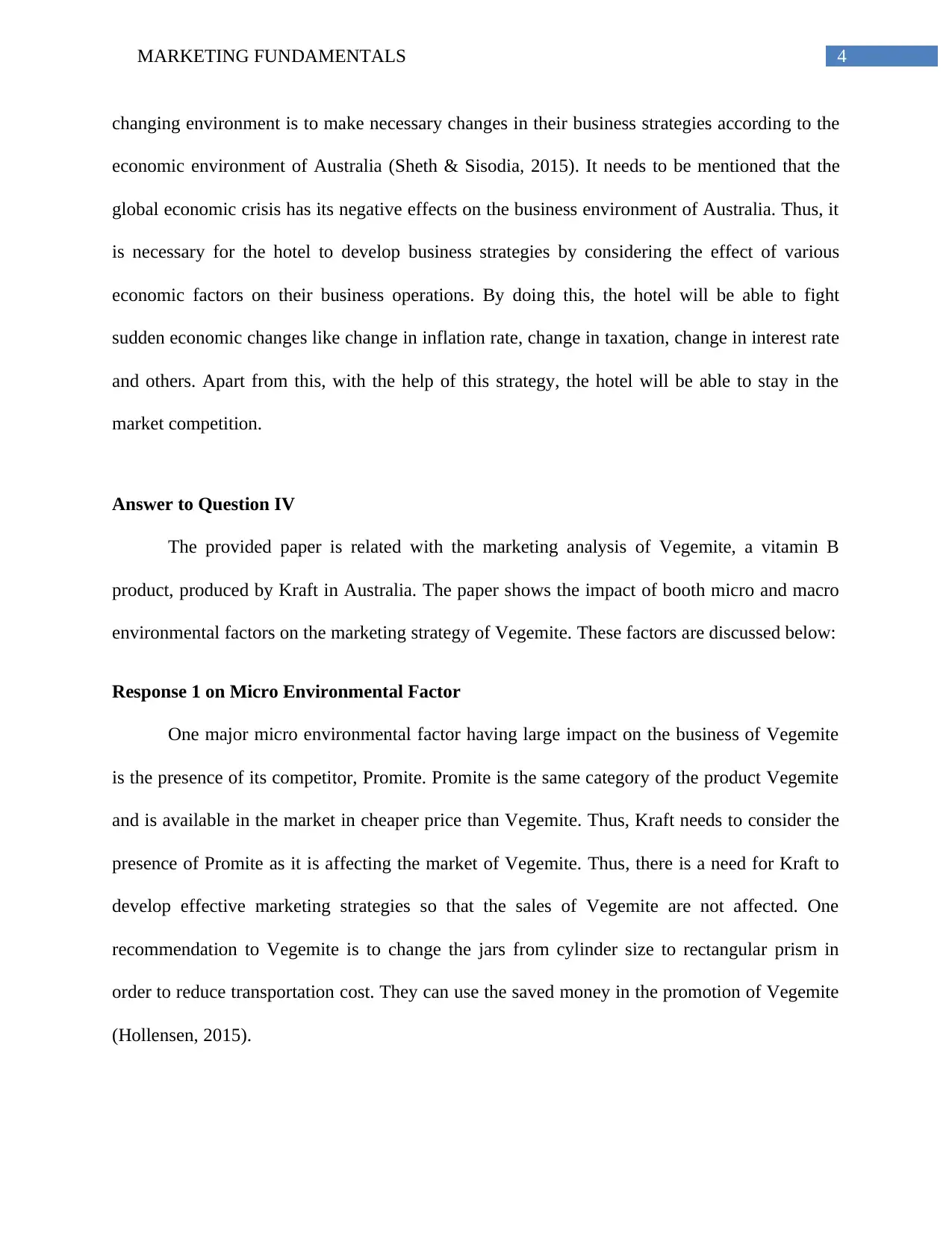
4MARKETING FUNDAMENTALS
changing environment is to make necessary changes in their business strategies according to the
economic environment of Australia (Sheth & Sisodia, 2015). It needs to be mentioned that the
global economic crisis has its negative effects on the business environment of Australia. Thus, it
is necessary for the hotel to develop business strategies by considering the effect of various
economic factors on their business operations. By doing this, the hotel will be able to fight
sudden economic changes like change in inflation rate, change in taxation, change in interest rate
and others. Apart from this, with the help of this strategy, the hotel will be able to stay in the
market competition.
Answer to Question IV
The provided paper is related with the marketing analysis of Vegemite, a vitamin B
product, produced by Kraft in Australia. The paper shows the impact of booth micro and macro
environmental factors on the marketing strategy of Vegemite. These factors are discussed below:
Response 1 on Micro Environmental Factor
One major micro environmental factor having large impact on the business of Vegemite
is the presence of its competitor, Promite. Promite is the same category of the product Vegemite
and is available in the market in cheaper price than Vegemite. Thus, Kraft needs to consider the
presence of Promite as it is affecting the market of Vegemite. Thus, there is a need for Kraft to
develop effective marketing strategies so that the sales of Vegemite are not affected. One
recommendation to Vegemite is to change the jars from cylinder size to rectangular prism in
order to reduce transportation cost. They can use the saved money in the promotion of Vegemite
(Hollensen, 2015).
changing environment is to make necessary changes in their business strategies according to the
economic environment of Australia (Sheth & Sisodia, 2015). It needs to be mentioned that the
global economic crisis has its negative effects on the business environment of Australia. Thus, it
is necessary for the hotel to develop business strategies by considering the effect of various
economic factors on their business operations. By doing this, the hotel will be able to fight
sudden economic changes like change in inflation rate, change in taxation, change in interest rate
and others. Apart from this, with the help of this strategy, the hotel will be able to stay in the
market competition.
Answer to Question IV
The provided paper is related with the marketing analysis of Vegemite, a vitamin B
product, produced by Kraft in Australia. The paper shows the impact of booth micro and macro
environmental factors on the marketing strategy of Vegemite. These factors are discussed below:
Response 1 on Micro Environmental Factor
One major micro environmental factor having large impact on the business of Vegemite
is the presence of its competitor, Promite. Promite is the same category of the product Vegemite
and is available in the market in cheaper price than Vegemite. Thus, Kraft needs to consider the
presence of Promite as it is affecting the market of Vegemite. Thus, there is a need for Kraft to
develop effective marketing strategies so that the sales of Vegemite are not affected. One
recommendation to Vegemite is to change the jars from cylinder size to rectangular prism in
order to reduce transportation cost. They can use the saved money in the promotion of Vegemite
(Hollensen, 2015).
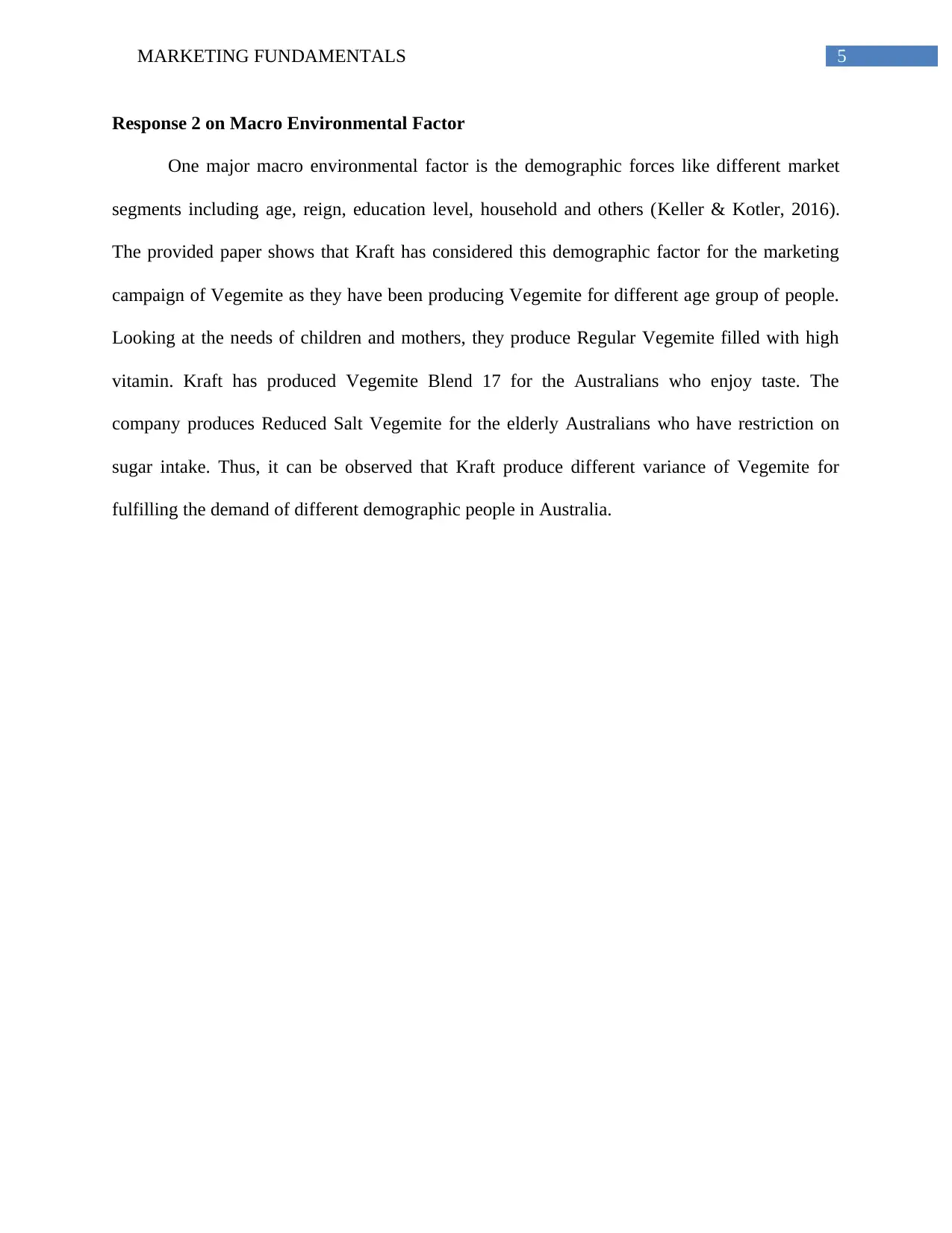
5MARKETING FUNDAMENTALS
Response 2 on Macro Environmental Factor
One major macro environmental factor is the demographic forces like different market
segments including age, reign, education level, household and others (Keller & Kotler, 2016).
The provided paper shows that Kraft has considered this demographic factor for the marketing
campaign of Vegemite as they have been producing Vegemite for different age group of people.
Looking at the needs of children and mothers, they produce Regular Vegemite filled with high
vitamin. Kraft has produced Vegemite Blend 17 for the Australians who enjoy taste. The
company produces Reduced Salt Vegemite for the elderly Australians who have restriction on
sugar intake. Thus, it can be observed that Kraft produce different variance of Vegemite for
fulfilling the demand of different demographic people in Australia.
Response 2 on Macro Environmental Factor
One major macro environmental factor is the demographic forces like different market
segments including age, reign, education level, household and others (Keller & Kotler, 2016).
The provided paper shows that Kraft has considered this demographic factor for the marketing
campaign of Vegemite as they have been producing Vegemite for different age group of people.
Looking at the needs of children and mothers, they produce Regular Vegemite filled with high
vitamin. Kraft has produced Vegemite Blend 17 for the Australians who enjoy taste. The
company produces Reduced Salt Vegemite for the elderly Australians who have restriction on
sugar intake. Thus, it can be observed that Kraft produce different variance of Vegemite for
fulfilling the demand of different demographic people in Australia.
⊘ This is a preview!⊘
Do you want full access?
Subscribe today to unlock all pages.

Trusted by 1+ million students worldwide
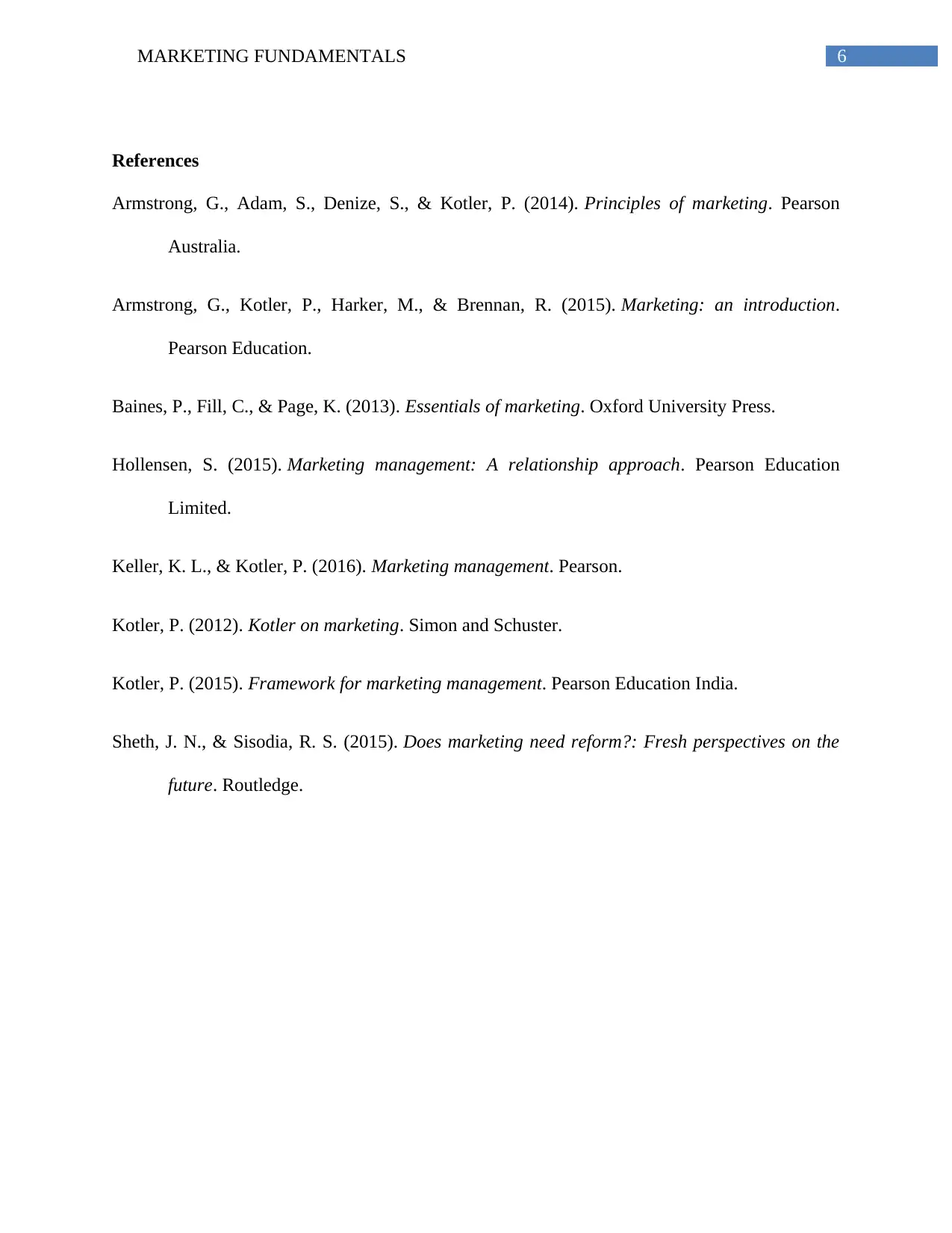
6MARKETING FUNDAMENTALS
References
Armstrong, G., Adam, S., Denize, S., & Kotler, P. (2014). Principles of marketing. Pearson
Australia.
Armstrong, G., Kotler, P., Harker, M., & Brennan, R. (2015). Marketing: an introduction.
Pearson Education.
Baines, P., Fill, C., & Page, K. (2013). Essentials of marketing. Oxford University Press.
Hollensen, S. (2015). Marketing management: A relationship approach. Pearson Education
Limited.
Keller, K. L., & Kotler, P. (2016). Marketing management. Pearson.
Kotler, P. (2012). Kotler on marketing. Simon and Schuster.
Kotler, P. (2015). Framework for marketing management. Pearson Education India.
Sheth, J. N., & Sisodia, R. S. (2015). Does marketing need reform?: Fresh perspectives on the
future. Routledge.
References
Armstrong, G., Adam, S., Denize, S., & Kotler, P. (2014). Principles of marketing. Pearson
Australia.
Armstrong, G., Kotler, P., Harker, M., & Brennan, R. (2015). Marketing: an introduction.
Pearson Education.
Baines, P., Fill, C., & Page, K. (2013). Essentials of marketing. Oxford University Press.
Hollensen, S. (2015). Marketing management: A relationship approach. Pearson Education
Limited.
Keller, K. L., & Kotler, P. (2016). Marketing management. Pearson.
Kotler, P. (2012). Kotler on marketing. Simon and Schuster.
Kotler, P. (2015). Framework for marketing management. Pearson Education India.
Sheth, J. N., & Sisodia, R. S. (2015). Does marketing need reform?: Fresh perspectives on the
future. Routledge.
1 out of 7
Related Documents
Your All-in-One AI-Powered Toolkit for Academic Success.
+13062052269
info@desklib.com
Available 24*7 on WhatsApp / Email
![[object Object]](/_next/static/media/star-bottom.7253800d.svg)
Unlock your academic potential
Copyright © 2020–2025 A2Z Services. All Rights Reserved. Developed and managed by ZUCOL.




